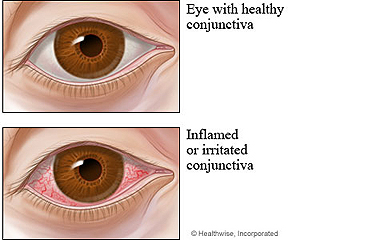Allergic Conjunctivitis in Children: Care Instructions
Overview

Allergic conjunctivitis (say "kun-JUNK-tih-VY-tus") is an eye problem that many children get. It is often
called pinkeye. In pinkeye, the lining of the eyelid and the eye surface become red and swollen. The lining is
called the conjunctiva (say "kawn-junk-TY-vuh").
Pinkeye can be caused by bacteria, a virus, or an allergy.
Your child's pinkeye is caused by an allergy. A substance (allergen) triggers a reaction that results
in the symptoms. This type of pinkeye cannot be spread from person to person. Your child may have other
symptoms of an allergy, such as a runny nose.
Allergic pinkeye goes away when you keep your child away from the allergen that triggers the pinkeye.
Triggers include pollen, mold, and animal skin cells (dander). But because it is not always possible to stay
away from triggers, your doctor may suggest eyedrops to treat the symptoms. Antibiotics do not help with
allergies.
Follow-up care is a key part of your child's treatment and safety. Be sure to make and go to all
appointments, and call your doctor if your child is having problems. It's also a good idea to know your
child's test results and keep a list of the medicines your child takes.
How can you care for your child at home?
Use medicines as directed
-
Have your child take medicines exactly as prescribed. Call your doctor if you think your child is having a
problem with a medicine. You will get more details on the specific medicines your doctor prescribes.
-
If the doctor gave your child eyedrops, use them as directed. Keep the bottle tip clean. To put in
eyedrops:
-
Tilt your child's head back and pull the lower eyelid down with one finger.
-
Drop or squirt the medicine inside the lower lid.
-
Have your child close the eye for 30 to 60 seconds to let the drops move around.
-
Do not touch the tip of the bottle to your child's eyelashes or any other surface.
Make your child comfortable
-
Use moist cotton or a clean, wet cloth to remove the crust from your child's eyes. Wipe from the inside
corner of the eye to the outside. Use a clean part of the cloth for each wipe.
-
Put cold or warm wet cloths on your child's eyes a few times a day if the eyes hurt or are itching.
-
Do not have your child wear contact lenses until the pinkeye is gone. Clean the contacts and storage case.
-
If your child wears disposable contacts, get out a new pair when the eyes have cleared and it is safe to
wear contacts again.
Avoid triggers
When should you call for help?
 Call your
doctor now or seek immediate medical care if:
Call your
doctor now or seek immediate medical care if:
Watch closely for changes in your child's health, and be sure to contact your doctor if:
Current as of: June 5, 2023
Content Version: 14.0
Care instructions adapted under license by your
healthcare professional. If you have questions about a medical condition or this instruction, always ask
your healthcare professional. Healthwise, Incorporated disclaims any warranty or liability for your use of
this information.